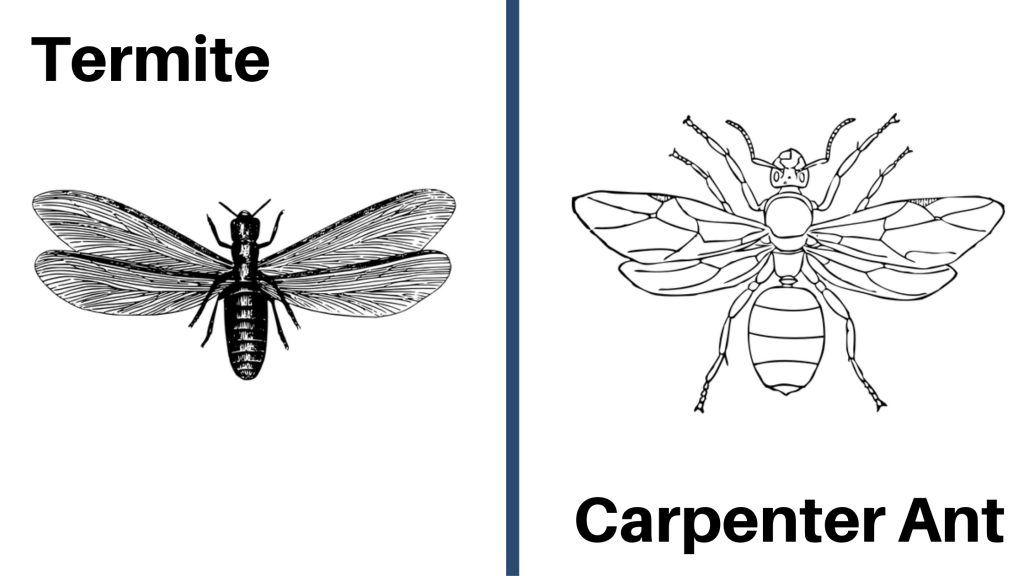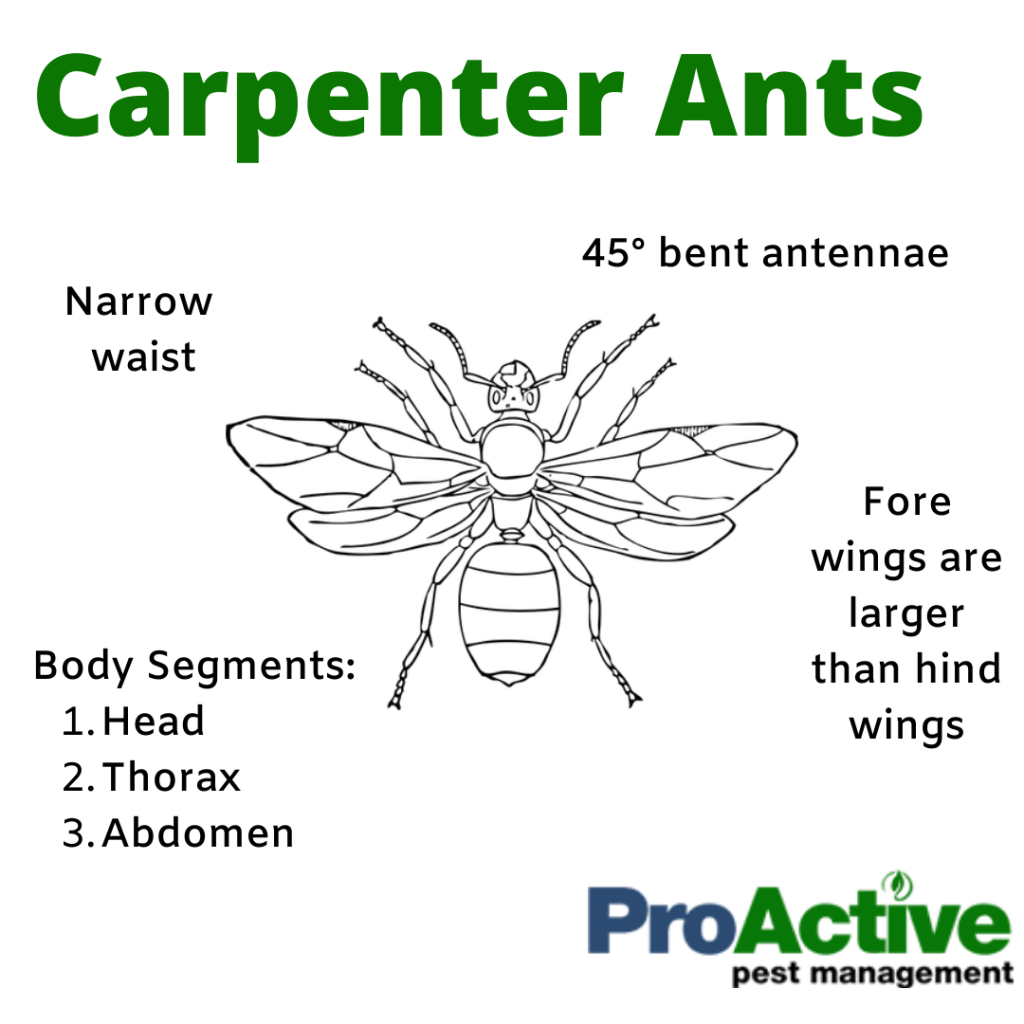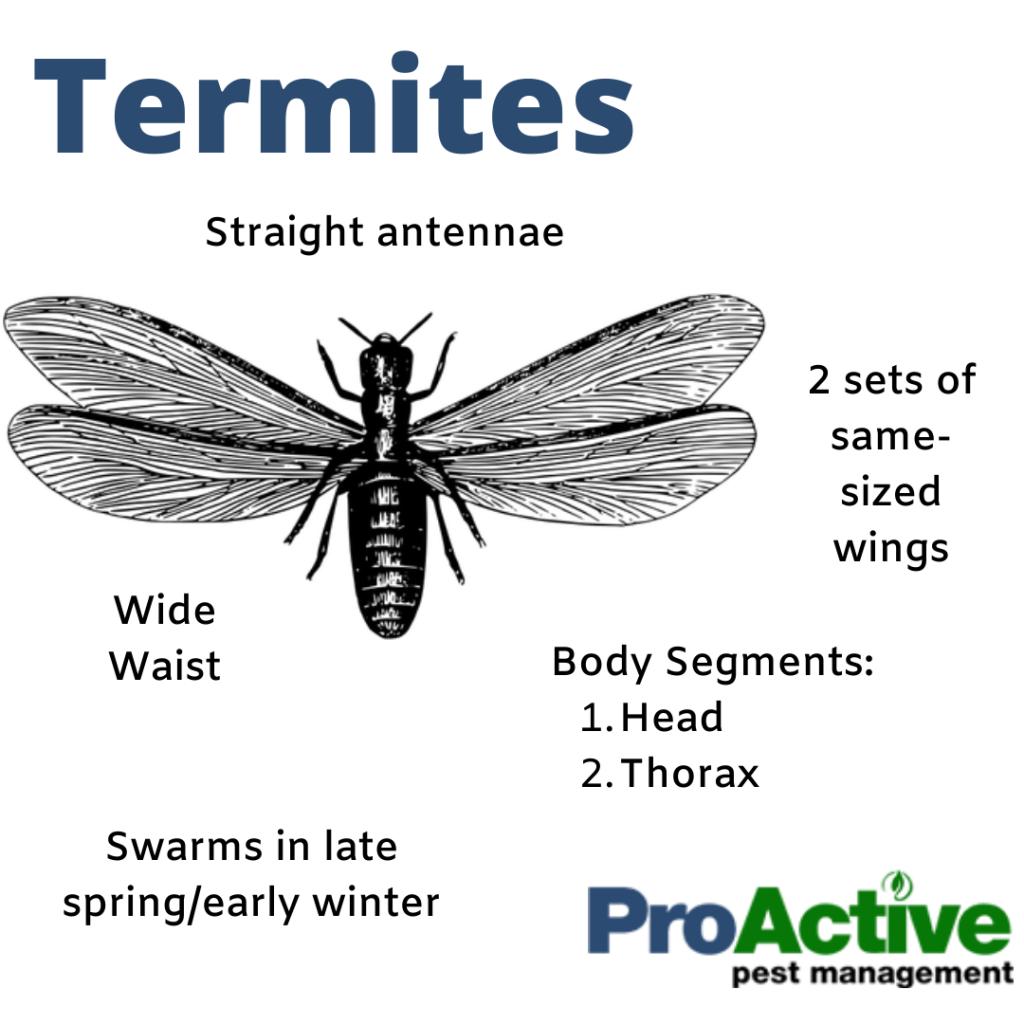
As a homeowner, the last thing you want is structural damage to your home. It’s important to know the difference between termites vs carpenter ants. Unfortunately, both termites and carpenter ants can cause significant structural damage if left unchecked. But how can you tell which one you are dealing with? While these insects are similar in appearance and behavior, there are several easily identifiable differences between the two, and infestations are handled and treated differently.
At ProActive Pest Management, we are experts in identifying and treating wood destroying ants, and we’re happy to refer out to a licensed termite exterminator. Read on to learn more about the differences between ants and termites and learn to identify the signs they leave behind around your home.
What’s the Difference Between Termites and Carpenter Ants?
Both termites and carpenter ants are capable of causing structural damage to your home or business by chewing through damp wood. Both are winged in their reproductive phase, during which point they are called “swarmers.” It is at this stage that the two insects look most similar.
If you are physically seeing what you think could be a carpenter ant or termite, odds are that you are looking at a carpenter ant, as they are more commonly found in the Midwest and frequently send scouts out to forage around and inside homes even if the colony is further away. Termites favor more humid conditions and are much more reclusive, rarely leaving the walls that provide them with food and shelter at the same time.
Though these two insects have a lot in common, both in the way they behave as well as the damage they cause, there are several simple ways to tell them apart. These differences can be spotted in three main places on each insect: the antennae, the body segments, and the wings (if they are present).

Identifying Carpenter Ants
Carpenter ants are large and dull black or occasionally red-colored, reaching around half an inch in length. Most ants are shiny and smaller. So, this is a good indicator you are looking at a carpenter ant already if you have found a large but not shiny ant. They have three distinct body segments–the head, abdomen, and thorax. Their antennae are bent at a 45-degree angle. And their wings, if present, will be two pairs that are differently sized–their forewings are larger than their hindwings. Notice the bent antennae, three distinct body segments, and two sets of differently sized wings in the picture below of a male swarmer carpenter ant.

Identifying Termites
Termites only look similar to carpenter ants when they are in the swarming stage–the rest of the time, they look far less alike. Swarmer termites only have 2 body segments–the head and the thorax. Their body color is usually light brown or closer to translucent, compared to the much darker carpenter ant. They get to be about the same size–between a quarter and a half inch. They do not have a narrow waist like ants do. Their antennae are straight or might be curled, but do not have the sharp-angled bend found on carpenter ants.
And on swarmer termites, both pairs of wings are the same size. If either of these are flying right at you it may be difficult to tell which you are dealing with, but simply seeing the insect (even from a few feet away) you should be able to spot the differences between the two by checking the body, antennae, and wings.z
How to Identify Carpenter Ant Infestations
Carpenter ants form their colonies on trees before they enter your home, so start by looking outside. If you are seeing carpenter ants outside, this may be a sign they are looking for ways to enter your home–but carpenter ants do send scouts from the colony to forage further away, so simply seeing a few carpenter ants outside is by no means a sure sign they are also in your home. While you are outside, check out any trees you have on your property.
Finding dead wood or fallen branches outside of your home may be an indicator that carpenter ants are active inside the tree. And if you have trees that lean, fall over, or die too soon, this could be another sign that carpenter ants have taken over and may be looking to establish a satellite colony inside your home.
Since carpenter ants dig through wood, check for signs of wood damage around your home. If you find weak flaky wood that you can crumble in your hands that looks like sawdust, you may be dealing with carpenter ants. They can chew through interior walls, wood furnishings, stairs, and even wood furniture. If the wood is damp, carpenter ants are more likely to want to live in it, as it is easier for them to work through.
Treated wood is more difficult for them to tunnel through, though unfortunately not impossible. Finding wood shavings is another sign that carpenter ants have invaded, as they do not eat the wood and are simply hollowing it out. Carpenter ants eat sugary or protein-rich food, like spilled drinks or even your pet’s food, unlike termites who actually eat the wood itself.
How to Identify Termite Infestations
Termites cause several billion dollars of damages in the US every year, so intervening as quickly as possible is crucial. Unfortunately, termites are more secretive than carpenter ants, rarely leaving walls or structures once they get inside or unless they are actively swarming, and for this reason, they can be harder to spot. But there are still some signs you can look out for.
One is discarded wings clustered or heaped outside or within your home. As swarmer termites begin working on a new colony, they discard their wings, sometimes creating piles of their wings which they no longer need. If you find them outside, that means swarmer termites are trying to (and may have already) come in. But finding them inside the home, especially next to a small hole in the wall, is a sign that they are inside already.
Another thing to look out for is mud tubes. Also called shelter tubes, these are made of wood and dirt mixed with liquids including termite saliva and termites create them so they can move between their feeding sites and nest without becoming dehydrated. If you spot these and are brave enough, you can break it open and check to see if it has been repaired the next day. This is a sure sign of an active infestation.
Termites, like carpenter ants, chew through wood, ingesting the cellulose rather than discarding it. This means that wood damage is another sign of a termite infestation. But since termites stay hidden, this damage may be harder to spot. Look for tiny holes in your drywall, and if you are concerned there may be termites behind the wall, tap on it to see if it sounds hollow. Sagging or squeaking floorboards can be another sign there are termites underneath.
Termite activity can look a lot like water damage, so if you suddenly find signs of what appears to be water damage (like discolored walls or a mold/mildew scent that termite colonies produce) with no apparent source, your culprit might be termites.
Termite Control
Termite infestations are best left to the professionals, with 2300 different species exhibiting differences in their behaviors and the types of damage they do to a home. Smaller termite colonies might not cause visible damage for up to two years, but several million termites can destroy a home within a year. While ProActive Pest Management does not offer treatment for termites, you can always contact us if you are not sure whether you are dealing with termites or carpenter ants, and we will put you in touch with a professional termite exterminator if it is indeed termites you are dealing with.
Carpenter Ant Control
Though carpenter ants take longer to cause significant damage, their aggressive nature and multiple satellite colonies are practically impossible to tackle on your own. Whether you are dealing with carpenter ants at your home or business, you can trust that your carpenter ant problems will be handled professionally by the experts at ProActive Pest Management. Our carpenter ant services are backed by our guarantee, meaning that we offer free re-treatments if you are still seeing any carpenter ants. Just give us a call and we’ll come back out at no cost to you until the carpenter ants are gone!
Termites vs Carpenter Ants
It’s important that you know the difference between these two species and that you contract a pest professional to fully eradicate them in your home. Prevent structural damage by taking the ProActive approach to Carpenter Ant Control. Call (630) 451-8101 to speak with a friendly member of our customer care team who can help you distinguish termites vs. carpenter ants.
